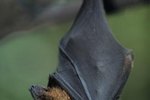
One of the most memorable aspects of a trip to the seashore is watching seagulls as they gracefully wing their way over the waves. The birds often alight to squabble over a tasty treat, sometimes being so bold as to approach your picnic trying to sneak a tidbit here or there. Interacting with seagulls up close allows you to see the color of their eyes, which can vary even among members of the same species.
Dark-Eyed Gulls
Most seagull species have brown eyes throughout their lifetime, with shades that vary from dark brown to nearly black. Commonly seen species include the California gull, black-headed gull, glaucous winged gull, Heermann's gull and Bonaparte's gull. Ivory gulls have dark black eyes throughout their lifetime.
Pale-Eyed Gulls
Other species of gull enter life with dark brown eyes that pale to gray and eventually golden-yellow in adulthood. The eye color changes in most species during the seagull's second winter. Herring gulls, lesser black-backed gulls and glaucous gulls are three species in which the adults have pale eye color.
References
Photo Credits
-
Medioimages/Photodisc/Photodisc/Getty Images
Writer Bio
Indulging her passion for vacation vagary through the written word on a full-time basis since 2010, travel funster Jodi Thornton-O'Connell guides readers to the unexpected, quirky, and awe-inspiring.


